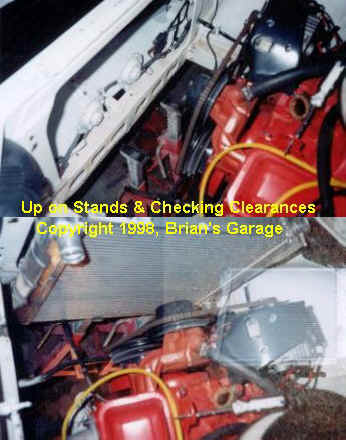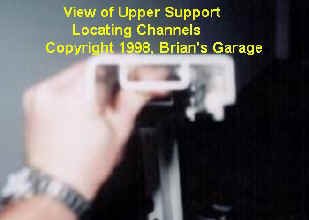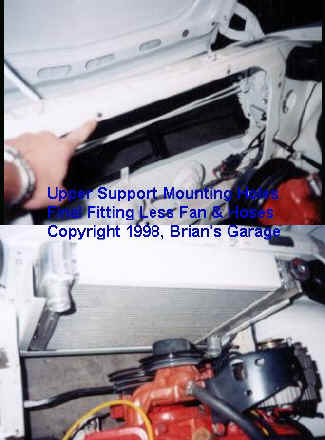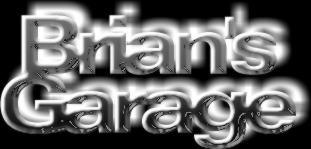How to Install a Griffin Radiator in the Early Z
This page details how to install a Griffin aluminum radiator into an early Datsun Z.
Background
My Z is Chevy V8 powered. I tried the rather large '79 ZX radiator, but it was
not quite efficient enough during the summer months (Note that the ZX radiator is
physically larger than the Griffin). I contacted Griffin radiator and explained my
situation. For my application they suggested a Nascar, 2 row, 1" tube, aluminum that
measures 24" wide and 19" tall. I then purchased the radiator, (P/N GRI-125202),
from Summit Racing, (1-800-230-3030), for $179.00.
After receiving the radiator, I measured everything and 3D modeled it with CAD.
I then measured my Z radiator core support and modeled it too. From these files, I
designed an attractive, lightweight, rigid, and adjustable mounting system. This system
required special tooling to fabricate and I would not expect the average mechanic to do
the same. However, the information supplied in this write-up should help get one started
and convey what to expect during the installation.
Basic Radiator Dimensions
The Griffin does not mount like a Z, or a Chevy. It does not use mounting
flanges, nor does it employ a designated supportive area on the tanks. It has C channel
rails, top & bottom. The C channel extends past the top and bottom of the tanks about
.2-.3". This is where the over all height (OAH) is measured and found to be
18.9". The tanks are actually 18.5" tall. The over all length (OAL) is measured
from outside edges of the tanks. This dimension is 24.0". The tanks are wider than
the core (2.25") and at the widest point (at the weld) are 3.1" wide. The water
inlet is 1.5" on the top left. The water outlet is 1.75" on the bottom right.
Note that the outlet has a slight angle towards the the Chevy water pump which takes a
little stress off of this fitting.
Fit Relative to Z Core Support
The Griffin fits, but not as well as one would like. When in the proper
position (gotta have about 1/2" between the hood and the cap), the lower channel will
be hanging down about 2" from the bottom of the lower core support rail. This is
measured at the lowest point of the support rail. Or, if measuring from the top of the
core support, 1/2" down to the top channel. Note that a radiator utilizing the the
slant corner filler will enable you to move the radiator up 1/2" to 1". I think
Ron Davis has one like this, but they are more expensive.
 Use jack stands to position
the the radiator while checking clearances. This radiator will need to be about 1/2"
down from the top of the core support. To check clearance between hood and cap, place a
piece of modeling clay on the cap and slowly lower the hood. Before completely closing,
check to see how much the clay has compressed. You don't want to knock a high spot in your
hood. Use jack stands to position
the the radiator while checking clearances. This radiator will need to be about 1/2"
down from the top of the core support. To check clearance between hood and cap, place a
piece of modeling clay on the cap and slowly lower the hood. Before completely closing,
check to see how much the clay has compressed. You don't want to knock a high spot in your
hood. In this pic you will see that the tanks will be visible through the grill opening
as the radiator core is narrower than the opening in the core support. |
Building The Lower Mount
The lower mount should form a C Channel. The radiator tank edges will be
located fore and aft off of the C channel sides. The radiator will be suspended on it's
lower aluminum channel by the center (web) of the C channel.
Since the radiator hangs down below the core support rail, it would be a good
idea to make the front side (flange) of the channel at least 2.5" tall to protect
from sticks and stones. The other flange need only be about 1.5" tall.
The inside dimension between flanges should be a minimum of 3.38". The
maximum width of the tanks is 3.12", which leaves you with .25" for some rubber
material. You gotta have rubber in between all aluminum to steel contact points. It
doesn't take a genius to figure out why. I used .094" thick rubber. You can use
whatever is available, i.e. inner-tube rubber.
The channel should be 25" long. The distance between frame rails is about
26.5".
 I made my
lower channel from 18 gauge and then welded this to a RH & LH 18 gauge Z section.
These Z sections had punched slots for up & down adjustment and bolted to the factory
radiator mounting holes. I made my
lower channel from 18 gauge and then welded this to a RH & LH 18 gauge Z section.
These Z sections had punched slots for up & down adjustment and bolted to the factory
radiator mounting holes.
|
Building The Upper Mount
The upper mount is also a C-channel. However, it does not locate the radiator
fore and aft using the sides of the tanks. The reason is that there really isn't much room
since one tank has a filler cap, and the other has an inlet in the way. Instead, locate
off the inside of the radiator upper channel.
I bent up an 18 gauge channel, 18.5" long. Flanges were 1.5" tall
with 3.38" measured inside between flanges.
 Next, I fabricated some more channel which fit
inside the radiator channel but left room for rubber isolation. These little channels were
welded to the inside of the larger piece. Next, I fabricated some more channel which fit
inside the radiator channel but left room for rubber isolation. These little channels were
welded to the inside of the larger piece. |
 I drilled
two holes in the core support and matching holes in the upper mount. 1/4 NC nuts were then
welded to the inside of the upper mount. This allowed for a really clean look and also let
me retain my hood prop and factory paint code decal (cool!). I drilled
two holes in the core support and matching holes in the upper mount. 1/4 NC nuts were then
welded to the inside of the upper mount. This allowed for a really clean look and also let
me retain my hood prop and factory paint code decal (cool!). |
Finishing Up
At this stage we should have our mounts completed and installed, rubber
isolation at all contact points, and the radiator sitting pretty. Time to install the
tranny cooler, radiator hoses, and electric fan. I'm not going to talk about tranny cooler
and fan mounting (those are obvious), but I would like to give a few pointers on finding
the right radiator hoses.
To find the correct radius of hose, take a length of copper or aluminum tubing
and bend it to match the inside radius of the hose you will need. For example, I put one
side against the engine thermostat housing and then routed it to the inlet of the Griffin.
I tried to use a straight path while allowing for about a 6" radius before the inlet
to the Griffin. Do the same thing for the lower hose.
Now, go to your local "friendly" Napa store. Ask to see the hose
selection (it's normally hung on a wall in the back). Check the label to see what size
each end of the hose is (can be different). Lay your piece of tubing against the inside
radius until you find a match.
 I ended up using a Gates/ECR
p/n 20608 for the lower hose and a Gates/ECR p/n 7368 for the top hose. I had to cut a
little off of each of these hoses. Note that the 20608 should work for a Chevy in the
"Set-Back" position also. I ended up using a Gates/ECR
p/n 20608 for the lower hose and a Gates/ECR p/n 7368 for the top hose. I had to cut a
little off of each of these hoses. Note that the 20608 should work for a Chevy in the
"Set-Back" position also. |
If you can't find a formed hose to fit, try a flex hose. The parts guys will
have a book listing hose lengths and diameters of each end of the flex hose. Flex hoses
generally wear out sooner and tend to restrict fluid flow.
Well, that's it. I hope this may have helped some of you.
| 